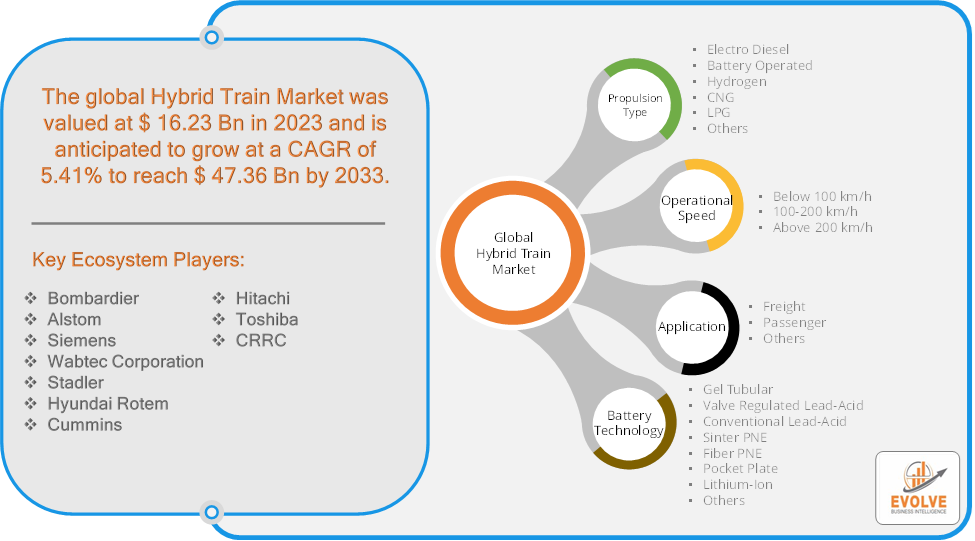Hybrid Train Market Expected to Achieve 5.41% CAGR Growth in the Forecast Period

Evolve Business Intelligence has published a research report on the Global Hybrid Train Market, 2023–2033. The global Hybrid Train Market is projected to exhibit a CAGR of around 5.41% during the forecast period of 2023 to 2033.
Evolve Business Intelligence has recognized the following companies as the key players in the global Hybrid Train Market: Bombardier, Alstom, Siemens, Wabtec Corporation, Stadler, Hyundai Rotem, Cummins, Hitachi, Toshiba and CRRC.
 More Information: https://evolvebi.com/report/hybrid-train-market-analysis/
More Information: https://evolvebi.com/report/hybrid-train-market-analysis/
Market Highlights
The Global Hybrid Train Market is projected to be valued at USD 47.36 Billion by 2033, recording a CAGR of around 5.41% during the forecast period. The Hybrid Train Market refers to the industry segment focused on the development, production, and sales of trains that use a combination of traditional energy sources (like diesel or electricity) and alternative power sources (such as batteries or hydrogen fuel cells) to operate. Hybrid trains aim to improve fuel efficiency, reduce emissions, and provide a more sustainable and cost-effective mode of transportation compared to conventional trains.
The Hybrid Train Market is an evolving sector with significant potential to transform the railway industry by offering more sustainable and efficient transportation solutions.
The COVID-19 pandemic had a significant impact on the Hybrid Train Market. The pandemic caused widespread disruptions in the global supply chain, leading to delays in the manufacturing and delivery of hybrid train components. Restrictions and lockdowns affected the availability of raw materials, which slowed down production processes. With travel restrictions and a significant decrease in passenger numbers, rail operators experienced reduced demand, impacting revenue and delaying new train orders. While freight operations were less affected than passenger services, there was still some impact due to fluctuations in demand for goods. The pandemic has heightened awareness of environmental issues, potentially accelerating the demand for cleaner and more sustainable transportation options like hybrid trains in the long term. Companies are likely to invest in technological advancements to improve efficiency and reduce costs, making hybrid trains more attractive post-pandemic. The pandemic has accelerated digital transformation, leading to more emphasis on smart technologies and energy management systems in train operations. Rail operators and manufacturers may face financial constraints, impacting their ability to invest in new hybrid train projects.
Segmental Analysis
The global Hybrid Train Market has been segmented based on Propulsion Type, Operational Speed, Application and Battery Technology.
Based on Propulsion Type, the Hybrid Train Market is segmented into Electro Diesel, Battery Operated, Hydrogen, CNG, LPG and Others. The Battery-Operated segment is anticipated to dominate the market.
Based on operational Speed, the Hybrid Train Market is segmented into Below 100 km/h, 100-200 km/h and Above 200 km/h. The Above 200 km/h segment is anticipated to dominate the market.
Based on Application, the Hybrid Train Market is segmented into Freight, Passenger and Others. The Freight segment is anticipated to dominate the market.
Based on Battery Technology, the global Hybrid Train Market has been divided into the Gel Tubular, Valve Regulated Lead-Acid, Conventional Lead-Acid, Sinter PNE, Fiber PNE, Pocket Plate, Lithium-Ion and Others. The Lithium-Ion segment is anticipated to dominate the market.
More Information: https://evolvebi.com/report/hybrid-train-market-analysis/
Regional Analysis
The Hybrid Train Market is divided into five regions: North America, Europe, Asia-Pacific, South America, and the Middle East, & Africa. The North American market is gradually embracing hybrid trains, driven by increasing awareness of environmental issues and government support for sustainable transport. Projects in the United States and Canada aim to modernize rail infrastructure and reduce emissions, supporting the hybrid train market. Europe is at the forefront of the hybrid train market due to stringent environmental regulations and a strong focus on sustainability. European countries, such as Germany, France, and the UK, have implemented policies and incentives to promote the adoption of hybrid and zero-emission trains. The Asia-Pacific region is experiencing rapid growth in the hybrid train market, driven by urbanization, population growth, and government initiatives to improve public transport. Countries like China, Japan, and India are investing heavily in rail infrastructure, creating opportunities for hybrid train deployment. Latin America presents emerging opportunities for hybrid trains, driven by increasing urbanization and the need for sustainable transport solutions. Some countries are beginning to explore hybrid train technologies as part of efforts to modernize rail networks and reduce emissions. The Middle East and Africa are investing in rail infrastructure development to enhance connectivity and reduce reliance on road transport. Countries in the Middle East, such as the UAE and Saudi Arabia, are exploring hybrid train technologies to align with sustainability goals and reduce emissions.


